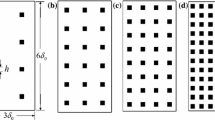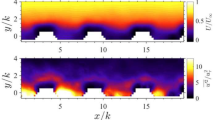Abstract
Drag partition measurements were made in the atmospheric inertial sublayer for six roughness configurations made up of solid elements in staggered arrays of different roughness densities. The roughness was in the form of a patch within a large open area and in the shape of an equilateral triangle with 60 m long sides. Measurements were obtained of the total shear stress (τ) acting on the surfaces, the surface shear stress on the ground between the elements (τS) and the drag force on the elements for each roughness array. The measurements indicated that τS quickly reduced near the leading edge of the roughness compared with τ, and a τS minimum occurs at a normalized distance (x/h, where h is element height) of \(\approx -42\) (downwind of the roughness leading edge is negative), then recovers to a relatively stable value. The location of the minimum appears to scale with element height and not roughness density. The force on the elements decreases exponentially with normalized downwind distance and this rate of change scales with the roughness density, with the rate of change increasing as roughness density increases. Average τS : τ values for the six roughness surfaces scale predictably as a function of roughness density and in accordance with a shear stress partitioning model. The shear stress partitioning model performed very well in predicting the amount of surface shear stress, given knowledge of the stated input parameters for these patches of roughness. As the shear stress partitioning relationship within the roughness appears to come into equilibrium faster for smaller roughness element sizes it would also appear the shear stress partitioning model can be applied with confidence for smaller patches of smaller roughness elements than those used in this experiment.
Similar content being viewed by others
Abbreviations
- A f :
-
frontal area of roughness elements (m2)
- A u :
-
unit area over which surface shear stress associated with a roughness element is distributed (m2)
- b :
-
element breadth (m)
- Cd :
-
surface drag coefficient
- Cd e :
-
roughness element drag coefficient
- Cd r :
-
rough surface drag coefficient
- Cd s :
-
smooth surface drag coefficient
- cv:
-
coefficient of variation
- d :
-
displacement height (m)
- F :
-
force on a roughness element (N)
- g :
-
acceleration due to gravity (m s−2)
- h :
-
element height (m)
- IBL:
-
internal boundary layer
- ISL:
-
inertial sublayer
- m :
-
empirical constant between 0 and 1
- n :
-
number of roughness elements occupying the ground area of the roughness array
- NDD:
-
normalized downwind distance (x/h)
- NED:
-
normalized element drag
- R :
-
average friction velocity ratio
- R l :
-
local friction velocity ratio at different positions in a roughness array
- Re :
-
Reynolds number
- R t :
-
threshold wind friction velocity ratio
- SD:
-
standard deviation of a mean value
- u :
-
wind speed (m s−1)
- u * :
-
wind friction velocity (m s−1)
- u * tR :
-
threshold wind friction velocity with roughness elements (m s−1)
- u * tS :
-
threshold wind friction velocity of bare surface (m s−1)
- x :
-
downwind distance (m)
- z :
-
reference height above surface (m)
- z w :
-
roughness sublayer height (m)
- z o :
-
aerodynamic roughness length (m)
- β:
-
ratio of element to surface drag coefficients
- φm :
-
dimensionless wind speed gradient
- κ:
-
von Kármán constant (0.4)
- λ:
-
roughness density
- μ:
-
molecular viscosity (N s m−2)
- ρa :
-
air density (kg m−3)
- σ:
-
roughness element basal area to frontal area ratio
- τ:
-
total surface shear stress (N m−2)
- τS :
-
surface shear stress on the area not covered by the roughness elements (N m−2)
- τR :
-
surface shear stress attributed to the roughness elements (N m−2)
References
Bradley EF (1968). A micrometeorological study of velocity profiles and surface drag in the region modified by a change in surface roughness. Quart J Roy Meteorol Soc 94:361–379
Cheng H, Castro IP (2002). Near wall flow over urban-like roughness. Boundary-Layer Meteorol 104:229–259
Crawley D, Nickling WG (2003). Drag partition for regularly-arrayed rough surfaces. Boundary-Layer Meteorol 107:445–468
Finnigan JJ (1979). Turbulence in waving wheat I. Mean statistics and honami. Boundary-Layer Meteorol 16:181–211
Garratt JR (1990). The internal boundary layer - a review. Boundary-Layer Meteorol 50:171–203
Gillette DA, Chen W (2001). Particle production and aeolian transport from a “supply-limited” source area in the Chihuahuan Desert, New Mexico, United States. J Geophys Res 106(D6):5267–5278
Gillette DA, Clayton RN, Mayeda TK, Jackson ML, Sridhar K (1978). Tropospheric aerosols from some major dust storms of the southwestern United States. J Appl Meteorol 17:832–845
Gillette D, Herrick J, Herbert G (2006). Wind characteristics of mesquite streets in the Northern Chihuahuan Desert, New Mexico, USA. Environ Fluid Mech 6(3):241–275
Gillies JA, Lancaster N, Nickling WG, Crawley D (2000). Field determination of drag forces and shear stress partitioning effects for a desert shrub (Sarcobatus vermiculatus, Greasewood. J Geophys Res Atmos 105(D20):24871–24880
Gillies JA, Nickling WG, King J (2002) Drag coefficient and plant form-response to wind speed in three plant species: Burning Bush (Euonymus alatus), Colorado Blue Spruce (Picea pungens glauca.), and Fountain Grass (Pennisetum setaceum). J Geophys Res Atmos 107(D24):10–1 – 10–15
Gillies JA, Nickling WG, King J (2006) Aeolian sediment transport through large patches of roughness in the atmospheric inertial sublayer. J Geophys Res – Earth Surface 111, F02006, doi:10.1029/2005JF000434
Irwin HPAH (1980). A simple omnidirectional sensor for wind tunnel studies of pedestrian level winds. J Wind Eng Ind Aero 7:219–239
Jackson PS (1981). On the displacement height in the logarithmic velocity profile. J Fluid Mech 111:15–25
Kaimal JC, Finnigan JJ (1994) Atmospheric boundary layer flows: their structure and measurement. Oxford University Press, New York, 289 pp
King J, Nickling WG, Gillies JA (2005) Representation of vegetation and other non-erodible elements in aeolian shear stress partitioning models for predicting transport threshold. J Geophys Res – Earth Surface 110, F04015, doi:10.1029/2004JF000281
Kutzbach JE (1961) Investigations of the modification of wind profiles by artificially controlled surface roughness. In: Lettau HH (ed) Studies of the three-dimensional structure of the planetary boundary layer. pp 71–113
Lancaster N, Baas A (1998). Influence of vegetation cover on sand transport by wind: field studies at Owens Lake California. Earth Surf Process Landf 25:68–82
Lettau HH (1969). Note on aerodynamic roughness parameter estimation on the basis of roughness element description. Appl Meteorol 8:828–832
Li A, Shao Y (2003). Numerical simulation of drag partition over rough surfaces. Boundary-Layer Meteorol 108:317–342
Luttmer C (2002) The partition of drag in salt grass communities. MS thesis, Guelph, Guelph, ON, Canada
Lyles L, Allison BE (1975). Wind erosion: Uniformly spacing nonerodible elements eliminates effects of wind direction variability. J Soil Water Conserv 30:225–226
MacDonald RW, Griffiths RF, Hall DJ (1998). An improved method for the estimation of surface roughness of obstacle arrays. Atmos Environ 31(11):1857–1864
Malin MC, Carr MH, Danielson GE, Davies ME, Hartmann WK, Ingersoll AP, James PB, Masursky H, McEwen AS, Soderblom LA, Thomas P, Veverka J, Caplinger MA, Ravine MA, Soulanille TA, Warren JL (1998). Early views of the Martian surface from the Mars Orbiter Camera of Mars Global Surveyor. Science 279(5357):1681–1685
Marshall JK (1971). Drag measurements in roughness arrays of varying density and distribution. Agric Meteorol 8:269–292
Monteiro JP, Viegas DX (1996). On the use of Irwin and Preston wall shear stress probes in turbulent incompressible flows with pressure gradients. J Wind Eng Ind Aero 64:15–29
Musick HB, Gillette DA (1990) Field evaluation of relationships between a vegetated structural parameter and sheltering against wind erosion. Land Degrad Rehab 2:87–94
Musick HB, Trujillo SM, Truman CR (1996). Wind-tunnel modelling of the influence of vegetation structure on saltation threshold. Earth Surf Process Landf 21(7):589–605
Okin GS, Gillette DA (2001). Distribution of vegetation in wind-dominated landscapes: Implications for wind erosion modeling and landscape processes. J Geophys Res 106(D9):9673–9683
Panofsky HA, Townsend AA (1964). Change of terrain roughness and the wind profile. Quart J Roy Meteorol Soc 90:147–155
Rao KS, Wyngaard JC, Coté OR (1974). The structure of two-dimensional internal boundary layer over a sudden change of surface roughness. J Atmos Sci 31:738–746
Raupach MR (1992). Drag and drag partition on rough surfaces. Boundary-Layer Meteorol 60:375–395
Raupach MR, Gillette DA, Leys JF (1993). The effect of roughness elements on wind erosion threshold. J Geophys Res 98(D2):3023–3029
Raupach MR, Thom AS, Edwards I (1980). A wind-tunnel study of turbulent flow close to regularly arrayed rough surfaces. Boundary-Layer Meteorol 18:373–397
Schlichting H (1936). Experimentelle untersuchungen zum rauhigkeitsproblem. Ingen – Arch 7:1–34
Taylor PA (1988) Turbulent wakes in the atmospheric boundary layer. In: Steffen WL, Denmead OT (eds) Flow and transport in the natural environment: advances and application. Springer-Verlag, Berlin, pp 270–292
Thom AS (1971). Momentum absorption by vegetation. Quart J Roy Meteorol Soc 97:414–428
Wieringa J (1993). Representative roughness parameters for homogeneous terrain. Boundary-Layer Meteorol 63:323–363
Wilson SA, Zimbelman JR (2004). Latitude-dependent nature and physical characteristics of transverse aeolian ridges on Mars. J Geophys Res 109:E10003, doi: 10.1029/2004JE002247
Wolfe SA, Nickling WG (1996). Shear stress partitioning in sparsely vegetated desert canopies. Earth Surf Process Landf 21:607–619
Wooding RA, Bradley EF, Marshall JK (1973) Drag due to regular arrays of roughness elements of varying geometry. Boundary-Layer Meteorol 5:285–308
Wu H, Stathopoulos T (1994). Further experiments on Irwin’s surface wind sensor. J Wind Eng Ind Aero 53:441–452
Wyatt V, Nickling WG (1997). Drag and shear stress partitioning in sparse desert creosote communities. Can J Earth Sci 34:1486–1498
Author information
Authors and Affiliations
Corresponding author
Rights and permissions
About this article
Cite this article
Gillies, J.A., Nickling, W.G. & King, J. Shear stress partitioning in large patches of roughness in the atmospheric inertial sublayer. Boundary-Layer Meteorol 122, 367–396 (2007). https://doi.org/10.1007/s10546-006-9101-5
Received:
Accepted:
Published:
Issue Date:
DOI: https://doi.org/10.1007/s10546-006-9101-5




